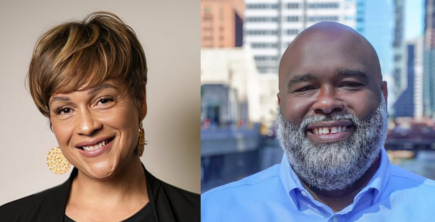
Our Community
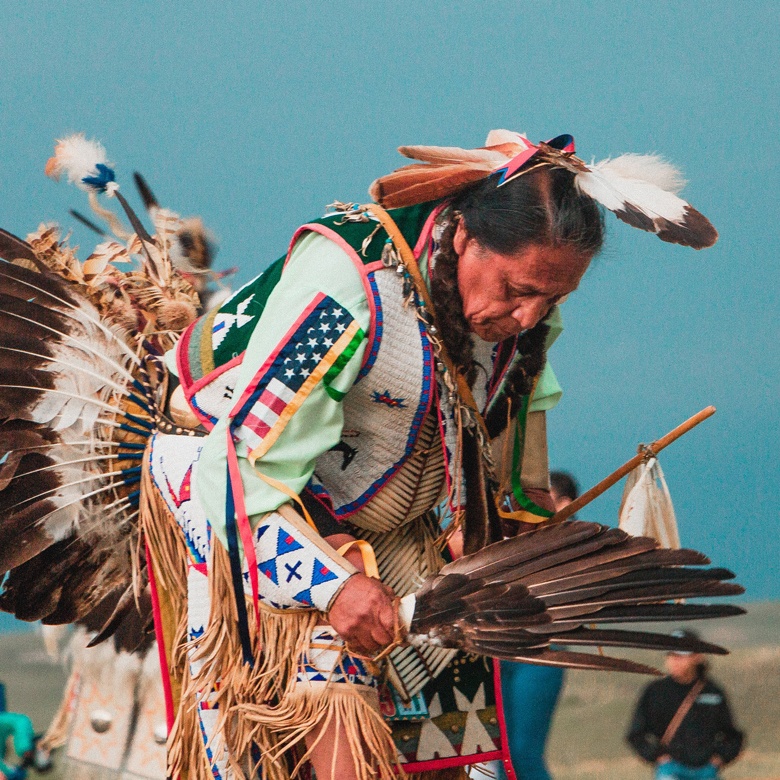
“It’s really tough when I think of elders not being present to teach our ways to the young,” says Petra Harmon One Hawk with tears in her eyes. As the director of the Standing Rock Sioux Tribal Aging and Community Services Agency, she’s speaking about the detrimental impacts of assimilation on American Indians, now made worse by the disproportionate impact of COVID-19 on Native communities. Harmon One Hawk adds, “The Lakota teachings that I learned from my grandfather have helped carry me through my life. Elders are the glue in our communities. Without them, things would just fall apart.”
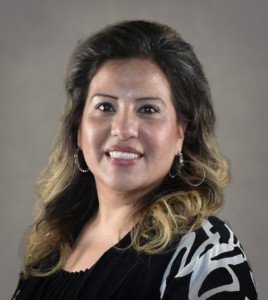
Harmon One Hawk and her dedicated team offer crucial supportive services to senior residents living on a reservation spanning North and South Dakota. This includes preparing 430 nutritious meals from scratch daily, 80 percent of which are delivered to the homes of elders with serious medical conditions or living in poverty.
While the coronavirus pandemic threatens tribes and tribal cultures across the U.S., the federal government has been tragically slow in providing American Indian communities with resources necessary to survive this latest health crisis. Fortunately, organizations like the First Nations Development Institute (FNDI)—a recipient of an expedited Indigenous COVID-19 grant docket facilitated by Tides Foundation—have stepped in to provide critical lifelines for public programs, including several at Harmon One Hawk’s agency.
“Early on in the pandemic, I shared with our Tribal Counsel that we weren’t on their [the U.S. Government’s] radar, and we needed our own plans in place…in the end they are going to shut the doors on us,” says Harmon One Hawk. “With COVID-19, everyone panicked. They stopped all the programs and services.” In fact, due to limits on ordering large quantities of food and a lack of protective gear for staff, her program’s meal delivery service stopped abruptly, which left clients without the food they needed for months.
During COVID-19, the combination of systemic barriers that limit access to resources and services—plus the reliance on federal dollars for infrastructure support—means that many tribes don’t have the support necessary to effectively meet heightened community needs.
Harmon One Hawk—an enrolled tribal member of the Standing Rock Sioux Tribe (who identify themselves as Lakota and/or Dakota)—is extremely passionate about serving her elders. She shares, “Elders hold the community accountable. They are the language and wisdom keepers among our people.”
Her program tries to prioritize the majority of participants who are full-time caregivers for their grandchildren because they often are living on a fixed income and have limited energy in their older age.
Living in a state of constant crisis is not new to American Indians, who have survived a brutal history of systemic racism with severe economic and health repercussions. This includes limited access to medical care, displacement from fertile lands during the building of dams, to now living in “food deserts.” Today, COVID-19 is hitting Harmon One Hawk’s home reservation hard because, as she explains, “The tribe started in a deficit. We were already in crisis mode before the pandemic started.”
Sixteen percent of homes in tribal areas are overcrowded and multigenerational, making social distancing impossible.
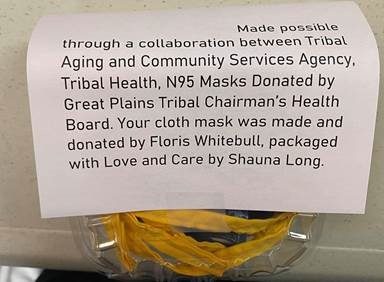
The Standing Rock Sioux Tribal Aging and Community Services Agency individually packages handmade masks for elders on dialysis. | ©Petra Harmon One Hawk
Indigenous communities are often invisible in “normal” times, and this neglect worsens in times of a national crisis. “During COVID-19, the combination of systemic barriers that limit access to resources and services—plus the reliance on federal dollars for infrastructure support—means that many tribes don’t have the support necessary to effectively meet heightened community needs,” says Victoria Sweet. She serves as the director of Indigenous Communities Grantmaking at NoVo Foundation, which advises a grantmaking fund at Tides Foundation that supports the critical infrastructure needs of Native-led organizations.
Since the start of the pandemic, both NoVo and FNDI have feared the damaging effects of COVID-19, given the pre-existing circumstances:
Despite the catastrophic health disparities above, Harmon One Hawk believes tribal communities can help regain control through food sovereignty work and initiatives like their agency’s Traditional Foods Pathway program, which dramatically improves the diets of elders.
Additionally, to help elders during the pandemic through training and education, Harmon One Hawk’s program has hired outreach coordinator Shauna Long. However, merely providing information is insufficient for those living in deep poverty, so Long and the agency staff are planning on distributing care kits, including masks, hand sanitizer, and educational booklets.
In a survey on “The Native Nonprofit Sector and the COVID-19 Pandemic” conducted by FNDI in June 2020, Native leaders noted that individuals in philanthropy need to be willing to listen and learn from Indigenous innovation. Given Tides’ 30-plus years of galvanizing support for Indigenous communities, Kimberly Middleton, senior advisor in Client Services at Tides, agrees—emphasizing that a reciprocal relationship is essential. She shares, “We may facilitate funding, but the recipients have the agency to determine where the funds need to go.”
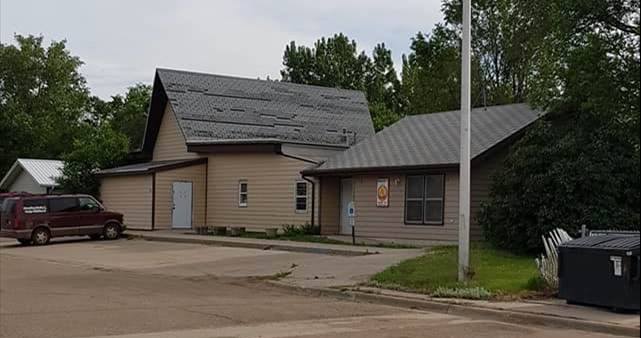
One of the agency’s nutrition sites in dire need of repairs. | ©Petra Harmon One Hawk
Middleton had previously accompanied a group of progressive donors to Standing Rock to explore how philanthropy could be supportive to the DAPL pipeline protests and to the larger social justice movement. She adds, “Our advisors are thinking creatively about how we can be of support to clients as collaborators. When our donors expressed their interest in supporting Indigenous communities impacted by COVID-19, I was personally moved to help do the research necessary to recommend an aligned docket of grants and act as the conduit that bridges the donors’ intent to organizations doing the critical work they want to support.”
Because of the generosity of our philanthropic partners, Tides was able to facilitate four expedited COVID-19 relief and response grants—totalling $2M—to support FNDI’s Emergency Response Fund, Hopi Foundation’s Emergency Assistance Fund, the Flicker Fund at Seventh Generation and The Navajo Nation COVID-19 Response Donation Fund.
When communities are free to define their own priorities and allocate the funds accordingly, resources can flow in the most effective and culturally appropriate ways.
“I’m grateful that our donor clients trust Tides to route these funds to the groups on the frontlines doing this lifesaving work, but it’s important to realize that there is so much more that needs to be done to support relief efforts, recovery, and resilience,” says Middleton.
The selected recipients were positioned as trusted leaders since the start of the pandemic, with proven infrastructures to redistribute resources in a way that empowers Native American communities. “When communities are free to define their own priorities and allocate the funds accordingly, resources can flow in the most effective and culturally appropriate ways,” adds Sweet.
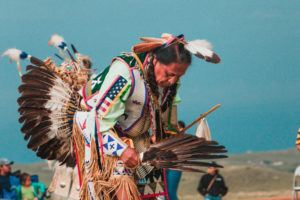
Pow-wows have been canceled on the reservation during COVID-19, but some people are still holding other small ceremonies using face masks, hand sanitizer, and social distancing measures. | Photo ©Andrew James / @andrewjamesphoto on Unsplash
The pandemic is both a professional and personal issue for Harmon One Hawk because her parents are high-risk—her mother is diabetic and her step-dad has cardiovascular issues. She recalls, “When one of our family friends, a huge supporter in language revitalization, died from it, it really hit home that it can affect us. So far, we have lost four elders.”
While there’s no glossing over the inexcusable disparities American Indians face during this public health crisis, they also display time-tested resilience in the face of great adversity.
Our elders are a testimony to the resilience of our people. They are a lot stronger than we think they are.
“During COVID,” Harmon One Hawk explains, “gatherings like pow wows are canceled, but creative alternatives are being developed,” for what she calls “an innate therapy” for many Native communities. “It lifts spirits and connects people, so we plan on putting loudspeakers on vehicles to play pow-wow music in communities.”
Harmon One Hawk looks to the elders for how to be resilient, too: “We underestimate our elders. They have lived through some major traumatic events in their lives. We don’t need to tell them what to do. They know. Our elders are a testimony to the resilience of our people. They are a lot stronger than we think they are.”
=============
→ If you’re a current Tides’ partner and interested in supporting Indigenous communities impacted by COVID-19—in relief and their recovery—please reach out to your Tides’ advisor.
→ If you’re not a partner, Tides has become a top accelerator and philanthropic partner for COVID‑19 response, and we invite you to join us by contacting [email protected].

Read the stories and hear the voices of social change leaders fighting for justice.